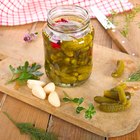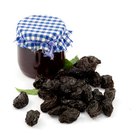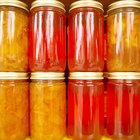As jars of home canned food cool, they make a loud popping noise. This popping noise is music to the home cook's ears because it means the food was canned properly and is most likely safe to store and use. Always inspect a jar of food when you open it, though, even if it popped during the cooling process.
What the Pop Means
When canning at home, you use glass jars topped with a two-piece vacuum cap, which consists of a metal band and a flat metal lid with a flanged edge. The underside of the lid is ringed with a rubber-like substance. When you heat filled canning jars in a pressure canner or boiling water bath canner, pressure builds inside the jars. During the cooling process, this pressure creates a vacuum effect, which causes the lids to seal on the jars. The popping sound indicates that the seal on the lid has closed tightly over the jars.
Post-Canning Instructions
How you handle the jars once they've completed their time in the canner can influence whether they seal or not. When the cooking time is complete, turn the heat off and carefully lift the lid away from you so you're not burned by the steam. Use a jar lifter and a hot pad to transfer the jars to a towel sitting on a counter. Leave at least 2 inches between each jar so air circulates freely. Let the jars set for 10 to 12 hours. Do not touch or disturb the jars during this time, which might interfere with them sealing. Only after they've cooled completely should you check to make sure they're sealed. If you heard them popping as they cooled, they're probably sealed, but gently push down on each one to double check. If the lids don't move, they've sealed properly. You can also tap them lightly with the back of a spoon. A clear, bright sound means they're sealed. A dull thud means the jars did not seal properly. In this case, refrigerate the canned food and use it within three days.
Troubleshooting Unsealed Jars
Occasionally a jar may fail to pop and seal for no apparent reason, but more often, this problem is related to issues with the jar. If a jar fails to seal, unscrew the band and remove the ring. Rub your finger around the edge of the jar. Often, tiny nicks in the jar are the cause for the failure. In this case, the jars should be thrown out after you've used the food. Sometimes fat or food particles left on the rim of the jar will cause the lid to fail to seal. Most lids can only be used once and must then be discarded. Unless a package specifically says that the lids are reusable, throw them out after one use. Otherwise, they may not seal properly. One final reason the lids may not seal is if you lifted the hot jars out by the lids. Let the jars set in the canner for five minutes after you turn off the heat. Remove the jar from the canner with a jar lifter and hold onto the neck of the can, rather than the top.
Home Canning Safety
Although home canning can be a safe, economical and satisfying way to preserve food, you must take food safety issues seriously. Conditions in a jar of improperly canned food are ideal for bacteria to grow. Some bacteria, including the one that causes botulism, can cause serious illness or even death. Use only canning recipes from credible sources, such as the USDA or university extension books and websites. Follow recipes exactly, and be sure to use a pressure canner when canning low-acid foods, including meats and most vegetables. Process foods for the recommended time, and increase canning time if you live more than 1,000 feet above sea level. Listening for the pop as the jars are cooling is only the first line of defense in keeping canned food safe. Store the jars properly in a cool, dry location and use them within one year. Canned foods may darken slightly over time, or you may notice a sediment in the bottom of the jar. These common problems don't affect the safety of the food. However, if the jar is open or bulging, or you notice a foul odor or signs of spoilage, discard the food carefully. Wear rubber gloves and dispose of the food in a trash can where children and pets won't have access.
Related Articles

How to Vacuum Seal Jars

Problems With Black on Canning Jar Rim
How to Heat Process Mason Jars to Seal

How to Can With Half-Pint Jars
How Long Are Canned Meat & Vegetables ...

How to Dry Pack Long-Term Food in Mason ...
How Long Can Food Stored in Canning ...
How to Preserve Salsa Made With Canned ...

How to Can Jelly Using a Pressure Canner

How to Can Venison Meat

Instructions for Canning With a ...

How to Process & Seal Hot Sauce Bottles

What Are the Best Containers to Freeze ...

The Safety of Refrigerators and ...

How to Preserve Sauerkraut

How to Preserve Pimentos

How to Bake in Mason Jars
Maximum Storage Temperature of Canned ...

The Steps in Cooking Raw Foods in a ...

How to Can Pickled Corn in Jars
References
- Ball Blue Book Guide to Home Canning, Freezing & Dehydration; Alltrista Corporation
- Clemson University Cooperative Extension: Common Canning Problems
Writer Bio
Julie Christensen is a food writer, caterer, and mom-chef. She's the creator of MarmaladeMom.org, dedicated to family fun and delicious food, and released a book titled "More Than Pot Roast: Fast, Fresh Slow Cooker Recipes."